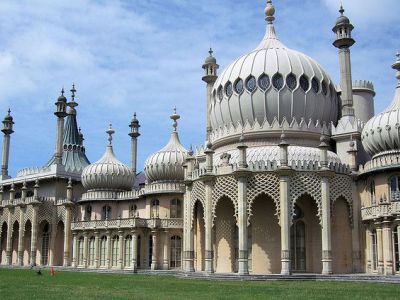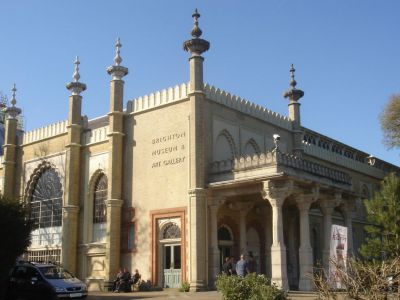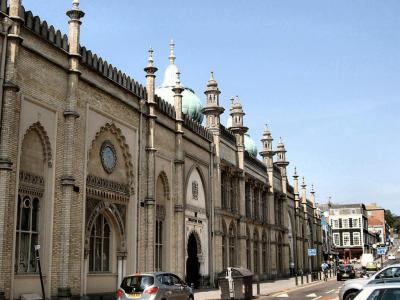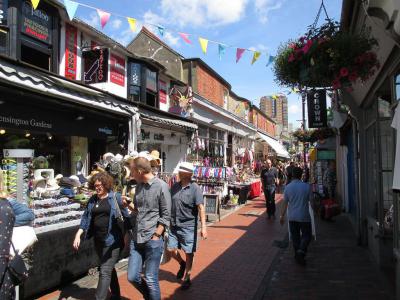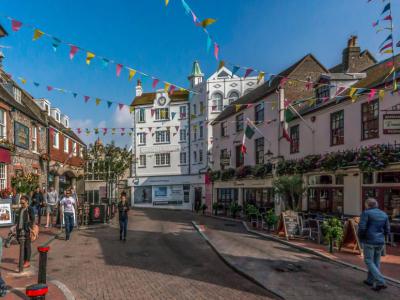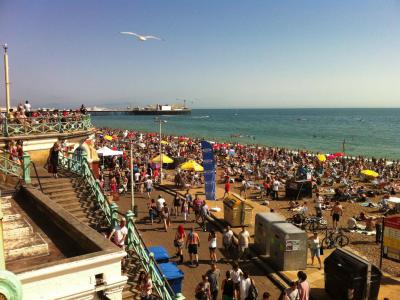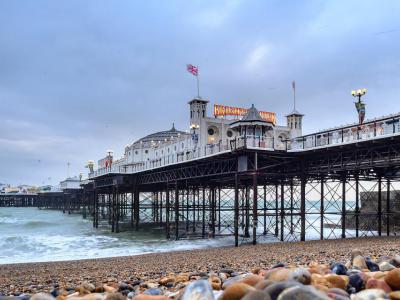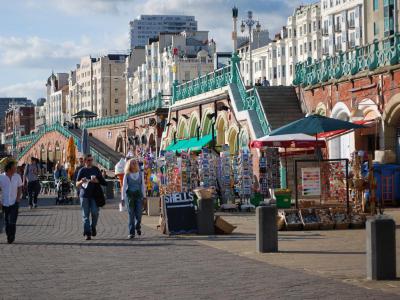Brighton Introduction Walking Tour (Self Guided), Brighton
The town of Bristelmestune is first mentioned in William the Conqueror's Domesday Book of 1085. In 1810 it officially became Brighton. The area of Brighton has known settlements since the Bronze Age. It experienced Celts, Saxons, Romans. But the train stopped with the arrival of the Normans in 1066.
When Conquering William took the helm, Bristelmestune was a fishing village of 400 souls. William established a rent for the town of 4000 herrings. As the Old Rabbi said, "Thank God for the herrings." Time marched on. In 1514 French Admiral Pregent de Bidoux sacked and burned the town. Recovery was relatively quick, thanks to more fishing.
Charles II was on the lam in Brighton in 1651 after losing the Battle of Worcester. Feeling rather saucy, he decamped for France in the good ship "Surprise." The town fell on hard times and declined seriously until the 1730s, when it began its dramatic recovery.
What goes up must come down and then it goes back up. Three things contributed to Brighton's renaissance. Doctor Richard Russell popularized the fad for healing by bathing in and drinking seawater. He moved his practice to Brighton. His well-heeled patients flocked to Brighton's pebbled beaches and dived in.
George, Prince of Wales, later King George IV, arrived in 1783. He liked Brighton so much he ordered his famous Royal Pavilion to be built. It is the most celebrated landmark of Brighton to this day. The arrival of the London and Brighton Railway in 1841 made it easy for London day-trippers to come. They're still coming.
Must see items in Brighton include the Royal Pavilion. Completed in the early 19th century by architect John Nash it is famous for its Indian-Arabic architecture. The Brighton Marine Palace Pier is a funfair with its restaurants and arcades. British Airways i360 lifts visitors high above the beach.
The list must also include Jubilee Square, the Brighton Clock Tower, Volk's Electric Railway, and the Grand Hotel. Saint Nicholas Church dates from the 11th century. Finally the beaches. The healing waters are still there. Water polo anyone?
When Conquering William took the helm, Bristelmestune was a fishing village of 400 souls. William established a rent for the town of 4000 herrings. As the Old Rabbi said, "Thank God for the herrings." Time marched on. In 1514 French Admiral Pregent de Bidoux sacked and burned the town. Recovery was relatively quick, thanks to more fishing.
Charles II was on the lam in Brighton in 1651 after losing the Battle of Worcester. Feeling rather saucy, he decamped for France in the good ship "Surprise." The town fell on hard times and declined seriously until the 1730s, when it began its dramatic recovery.
What goes up must come down and then it goes back up. Three things contributed to Brighton's renaissance. Doctor Richard Russell popularized the fad for healing by bathing in and drinking seawater. He moved his practice to Brighton. His well-heeled patients flocked to Brighton's pebbled beaches and dived in.
George, Prince of Wales, later King George IV, arrived in 1783. He liked Brighton so much he ordered his famous Royal Pavilion to be built. It is the most celebrated landmark of Brighton to this day. The arrival of the London and Brighton Railway in 1841 made it easy for London day-trippers to come. They're still coming.
Must see items in Brighton include the Royal Pavilion. Completed in the early 19th century by architect John Nash it is famous for its Indian-Arabic architecture. The Brighton Marine Palace Pier is a funfair with its restaurants and arcades. British Airways i360 lifts visitors high above the beach.
The list must also include Jubilee Square, the Brighton Clock Tower, Volk's Electric Railway, and the Grand Hotel. Saint Nicholas Church dates from the 11th century. Finally the beaches. The healing waters are still there. Water polo anyone?
How it works: Download the app "GPSmyCity: Walks in 1K+ Cities" from Apple App Store or Google Play Store to your mobile phone or tablet. The app turns your mobile device into a personal tour guide and its built-in GPS navigation functions guide you from one tour stop to next. The app works offline, so no data plan is needed when traveling abroad.
Brighton Introduction Walking Tour Map
Guide Name: Brighton Introduction Walking Tour
Guide Location: England » Brighton (See other walking tours in Brighton)
Guide Type: Self-guided Walking Tour (Sightseeing)
# of Attractions: 8
Tour Duration: 1 Hour(s)
Travel Distance: 2.2 Km or 1.4 Miles
Author: leticia
Sight(s) Featured in This Guide:
Guide Location: England » Brighton (See other walking tours in Brighton)
Guide Type: Self-guided Walking Tour (Sightseeing)
# of Attractions: 8
Tour Duration: 1 Hour(s)
Travel Distance: 2.2 Km or 1.4 Miles
Author: leticia
Sight(s) Featured in This Guide:
- Royal Pavilion
- Brighton Museum and Art Gallery
- Brighton Dome
- North Laine
- The Lanes
- Brighton Beach
- Brighton Palace Pier
- Brighton Seafront
1) Royal Pavilion (must see)
George, Prince of Wales, turned 21 in 1783. He liked living large. He had debts. He had gout. His doctor recommended a spell at the seaside. Fresh air, ocean views, just the thing. George took a trip to Brighton and found an erstwhile farmhouse, a kind of pavilion, a perfect bucolic retreat. He settled in with his friend, Maria Fitzherbert.
In 1787 Prince George commissioned architect Henry Holland to enlarge the building with the aim of creating a Marine Pavilion. Holland created a rotunda with a breakfast room, a dining room and a library done in the French neoclassical style. In 1802 a new dining room and a conservatory were added.
A riding school and stables done in an Indian style, much bigger than the Marine Pavilion, were built in 1803-1808. There was a hiatus in building until 1815 when Architect John Nash redesigned, enlarged and extended the Pavilion. His is the work that one sees today.
The palace is in the middle of Brighton. The exterior can best be called fanciful Indian-Islamic. The imaginative interior designs are mostly by Frederick Crace and decorator Robert Jones. The primary influences within are Chinese, Mughal, Islamic and Hindoo. Altogether an exotic masala and a bouncy alternative to Regency.
Prince George eventually became George IV, King of Britain in 1820. He died in 1830. George's successor, William IV, also stayed at the Pavilion on his visits to Brighton. Queen Victoria did not like Brighton and she got little privacy at the Pavilion. She claimed, "The people here are indiscreet."
The Royal Pavilion was sold to the town of Brighton in 1850. The purchase by the Town triggered the attraction of the Pavilion as a tourist mecca. Looking at the Pavilion today, one might be reminded of the opening of Samuel Taylor Coleridge's poem, KUBLA KHAN: "In Xanadu did Kubla Khan a stately pleasure-dome decree."
In 1787 Prince George commissioned architect Henry Holland to enlarge the building with the aim of creating a Marine Pavilion. Holland created a rotunda with a breakfast room, a dining room and a library done in the French neoclassical style. In 1802 a new dining room and a conservatory were added.
A riding school and stables done in an Indian style, much bigger than the Marine Pavilion, were built in 1803-1808. There was a hiatus in building until 1815 when Architect John Nash redesigned, enlarged and extended the Pavilion. His is the work that one sees today.
The palace is in the middle of Brighton. The exterior can best be called fanciful Indian-Islamic. The imaginative interior designs are mostly by Frederick Crace and decorator Robert Jones. The primary influences within are Chinese, Mughal, Islamic and Hindoo. Altogether an exotic masala and a bouncy alternative to Regency.
Prince George eventually became George IV, King of Britain in 1820. He died in 1830. George's successor, William IV, also stayed at the Pavilion on his visits to Brighton. Queen Victoria did not like Brighton and she got little privacy at the Pavilion. She claimed, "The people here are indiscreet."
The Royal Pavilion was sold to the town of Brighton in 1850. The purchase by the Town triggered the attraction of the Pavilion as a tourist mecca. Looking at the Pavilion today, one might be reminded of the opening of Samuel Taylor Coleridge's poem, KUBLA KHAN: "In Xanadu did Kubla Khan a stately pleasure-dome decree."
2) Brighton Museum and Art Gallery
After the Royal Pavilion was sold to the town of Brighton in 1850, it wasn't long before the Pavilion and Dome complex began hosting museum and art shows in the Great Kitchen. The kitchen and floor spaces soon proved inadequate for large exhibits. It was decided to stop improvising and build a dedicated museum space.
An extension was added to the Stables part of the complex. If the Stables once held up to 40 horses for George IV, they would certainly be roomy enough for paintings and exhibits. The space was walled off from Church Street and had previously been used for exercising horses. Not all the horses at once of course, but it was roomy.
The museum site was designed by Borough Surveyor Philip Lockwood. Lockwood used the dome and servants quarters to develop the museum and art gallery. The gallery opened in 1873. Its roof design was changed to the form of a shallow barrel vault. At first it housed a permanent collection. Today it displays Art Deco and Art Nouveau pieces.
The Art Gallery, library and museum are accessed from Church Street and then connect to the concert hall under the Dome. The Museum and Art Gallery is built into an extension of the Dome/Corn exchange buildings and is part of the Brighton Pavilion complex.
In 2005 the Jubilee Library opened, replacing the original library, which was moved above the museum. The former library was then converted to the Museum Lab.
An extension was added to the Stables part of the complex. If the Stables once held up to 40 horses for George IV, they would certainly be roomy enough for paintings and exhibits. The space was walled off from Church Street and had previously been used for exercising horses. Not all the horses at once of course, but it was roomy.
The museum site was designed by Borough Surveyor Philip Lockwood. Lockwood used the dome and servants quarters to develop the museum and art gallery. The gallery opened in 1873. Its roof design was changed to the form of a shallow barrel vault. At first it housed a permanent collection. Today it displays Art Deco and Art Nouveau pieces.
The Art Gallery, library and museum are accessed from Church Street and then connect to the concert hall under the Dome. The Museum and Art Gallery is built into an extension of the Dome/Corn exchange buildings and is part of the Brighton Pavilion complex.
In 2005 the Jubilee Library opened, replacing the original library, which was moved above the museum. The former library was then converted to the Museum Lab.
3) Brighton Dome (must see)
As soon as the Pavilion passed to the town, different uses were proposed for the Dome. The proposals were a swimming pool, law courts, and an assembly room. In 1866 workers began to execute the Moorish designs of Philip Lockwood.
Lockwood installed many paintings, stained glass and an enormous chandelier. The chandelier had more than 520 gas jets. There were also smaller chandeliers hanging around the room.
The woefully expensive chandeliers came down by 1934. The Dome was then completely done over with art deco designs by Robert Atkinson. The Concert hall was furnished with walnut paneling and a new entrance.
The Corn Exchange was initially the riding school for the Prince Regent. The space measured 174 feet long, 58 feet wide and 34 feet high. The roof was made with arched timbers for support. A new facade featured a statue of Ceres, goddess of corn, by James Woodford.
Mrs Maria Fitzherbert, a longtime lover and friend of George, once stabled her horses in the space now filled by the Studio Theatre. The stables became Dome Cottage, which in time became the Pavilion Theatre. In 2012 it was named the Studio Theatre.
Redevelopment is underway on the Corn Exchange and Studio Theatre. The aim is to restore heritage elements, cafes, bars and public areas the better to enjoy the exotic Regency architecture.
Lockwood installed many paintings, stained glass and an enormous chandelier. The chandelier had more than 520 gas jets. There were also smaller chandeliers hanging around the room.
The woefully expensive chandeliers came down by 1934. The Dome was then completely done over with art deco designs by Robert Atkinson. The Concert hall was furnished with walnut paneling and a new entrance.
The Corn Exchange was initially the riding school for the Prince Regent. The space measured 174 feet long, 58 feet wide and 34 feet high. The roof was made with arched timbers for support. A new facade featured a statue of Ceres, goddess of corn, by James Woodford.
Mrs Maria Fitzherbert, a longtime lover and friend of George, once stabled her horses in the space now filled by the Studio Theatre. The stables became Dome Cottage, which in time became the Pavilion Theatre. In 2012 it was named the Studio Theatre.
Redevelopment is underway on the Corn Exchange and Studio Theatre. The aim is to restore heritage elements, cafes, bars and public areas the better to enjoy the exotic Regency architecture.
4) North Laine (must see)
"Laine" means land holding in the old Sussex dialect. In the middle ages five of these "laines" made up the space surrounding present-day Brighton. One of these farm plots was North Laine. By the 19th century the plots had been encircled by Brighton town roads. The tracks that divided the plots from each other became streets.
In the 19th century, despite all the fuss about the Royal Pavilion, the North Laine was a hellish place, reviled for its abysmal poverty and squalor. Slaughterhouses did nothing to improve the quality of life. In the 1860s things began to move, however. The city began knocking down the rotten tenements and modernizing the streets.
Today North Laine is a hip beat shopping district, pedestrianized, popular and tourist friendly. It has retained the charm of the neighborhood without the dreck. It has an area bound by Trafalgar Street, Kensington Gardens, Sydney Street, Gardner street and Bond Street. It is replete with cafes, bars, theaters and comedy clubs.
Retail shops routinely sell antiques, salvaged items, used books, music, and all kinds of "retro" merchandise. Graphic novels, comics, musical instruments and paraphernalia can also be had. There is a high turn-over of "boutique" outlets.
Recently the City Council has built a library and a public square, "Jubilee Square." The North Laine doesn't grow vegetables any more. No more slaughterhouses either.
In the 19th century, despite all the fuss about the Royal Pavilion, the North Laine was a hellish place, reviled for its abysmal poverty and squalor. Slaughterhouses did nothing to improve the quality of life. In the 1860s things began to move, however. The city began knocking down the rotten tenements and modernizing the streets.
Today North Laine is a hip beat shopping district, pedestrianized, popular and tourist friendly. It has retained the charm of the neighborhood without the dreck. It has an area bound by Trafalgar Street, Kensington Gardens, Sydney Street, Gardner street and Bond Street. It is replete with cafes, bars, theaters and comedy clubs.
Retail shops routinely sell antiques, salvaged items, used books, music, and all kinds of "retro" merchandise. Graphic novels, comics, musical instruments and paraphernalia can also be had. There is a high turn-over of "boutique" outlets.
Recently the City Council has built a library and a public square, "Jubilee Square." The North Laine doesn't grow vegetables any more. No more slaughterhouses either.
5) The Lanes (must see)
Brighthelmston was a sleepy fishing village until Doctor Richard Russell came to visit in 1747. The good doctor had long extolled the health benefits of bathing in and drinking seawater. He recommended the waters around Brighthelmston, or Brighton, as it soon came to be called. In 1753 he moved his practice there.
Doctor Russell helped start the wave of "sea side" mania so popular in the latter half of the 18th century. The Prince of Wales and the Duke of Cumberland sought the seaside cure and they rented the doctor's house (after he died in 1759). The royal patronage had its effect. The sleepy town of Brighthelmston became big, exciting Brighton.
The Lanes are bounded by North Street in the north, Ship Street to the west and Prince Albert Street and Bartholomew Square in the south. The Lanes is also Brighton's most historic quarter. The streets are narrow and many 16th and 17th century houses remain.
One of the oldest buildings is the Cricketers Arms, the oldest public house in town. It is rumored to date from 1545. It is memorialized by Graham Greene in his novel "Brighton Rock." Strolling along narrow brick pathways called twittens, it is possible to become lost among boutiques, designer shops and galleries.
There are fabulous restaurants, cosy tea rooms and good old-fashioned pubs. No one starves in the Lanes. Not since George IV anyway.
For those who seek more shopping adventure, the North Laine is just a hop and a skip away.
Doctor Russell helped start the wave of "sea side" mania so popular in the latter half of the 18th century. The Prince of Wales and the Duke of Cumberland sought the seaside cure and they rented the doctor's house (after he died in 1759). The royal patronage had its effect. The sleepy town of Brighthelmston became big, exciting Brighton.
The Lanes are bounded by North Street in the north, Ship Street to the west and Prince Albert Street and Bartholomew Square in the south. The Lanes is also Brighton's most historic quarter. The streets are narrow and many 16th and 17th century houses remain.
One of the oldest buildings is the Cricketers Arms, the oldest public house in town. It is rumored to date from 1545. It is memorialized by Graham Greene in his novel "Brighton Rock." Strolling along narrow brick pathways called twittens, it is possible to become lost among boutiques, designer shops and galleries.
There are fabulous restaurants, cosy tea rooms and good old-fashioned pubs. No one starves in the Lanes. Not since George IV anyway.
For those who seek more shopping adventure, the North Laine is just a hop and a skip away.
6) Brighton Beach (must see)
Brighton Beach is different. It is a shingle beach. It has no sand. Not a grain. What it does have is pebbles, stones and some rocks. There is lots of wave energy. It is tamed here and there by strategically placed groynes, breakwaters, reaching into the surf. The water here is shallow and clear.
The beach shoreline within the city limits is eight miles long. A little more than five miles is shingle; pebbles, pebbles, everywhere. Brick chalets are available to rent on the Brighton shore. On the east side of the Palace Pier an area of sand is bared at low tide.
In that portion of the beach by Madeira Drive, east of the city center, there are courts for volley ball, ultimate frisbee and other beach games.
The City Council owns all the beaches. The sections of beach are divided by the breakwaters. Each section has a name: Boundary, Norfolk, Bedford, Metropole, Grand, Centre, King's, Old Ship, Volk's, Albion, Palace Pier, Aquarium, Athina, Paston, Banjo, Duke's, Cliff, Crescent, and Black Rock. Alert, Cliff Beach is nudist.
The eastern area of the Brighton seafront is developed and has one of Europe's biggest marinas. all along the front one can find restaurants, sports venues, amusement arcades, nightclubs and yes, bars. "By the sea, by the sea, oh how happy we'll be..."
The beach shoreline within the city limits is eight miles long. A little more than five miles is shingle; pebbles, pebbles, everywhere. Brick chalets are available to rent on the Brighton shore. On the east side of the Palace Pier an area of sand is bared at low tide.
In that portion of the beach by Madeira Drive, east of the city center, there are courts for volley ball, ultimate frisbee and other beach games.
The City Council owns all the beaches. The sections of beach are divided by the breakwaters. Each section has a name: Boundary, Norfolk, Bedford, Metropole, Grand, Centre, King's, Old Ship, Volk's, Albion, Palace Pier, Aquarium, Athina, Paston, Banjo, Duke's, Cliff, Crescent, and Black Rock. Alert, Cliff Beach is nudist.
The eastern area of the Brighton seafront is developed and has one of Europe's biggest marinas. all along the front one can find restaurants, sports venues, amusement arcades, nightclubs and yes, bars. "By the sea, by the sea, oh how happy we'll be..."
7) Brighton Palace Pier (must see)
Established in 1899, the Palace Pier is the third pier to be built in Brighton. The Royal Suspension Chain Pier and the West Pier came before the Palace Pier, but now only the Palace Pier still stands. It is managed by the Eclectic Bar Group. The Palace Pier replaced the Chain Pier which collapsed in 1896.
The Palace Pier remained in operation as a theatre venue until 1975. The theatre was demolished in 1986 and the pier became an amusement park featuring roller coasters. The Pier can be reached at the south end of the Old Steine by the Marine Parade and the Grand Junction Road on the waterfront. It is 1,722 feet long. Can't miss it.
The pier was designed and built by Richard St. George Moore. It cost 27,000 pounds to build and it had 3,000 lights for illumination. It had reading rooms which were replaced by a theatre. Stan Laural and Charlie Chaplin appeared there before their Hollywood days.
In 1984 the theatre was replaced by a dome with an amusement arcade. The seaward end of the pier had thrill rides, children's rides and roller coasters. Entertainment was still popular. The Spice Girls performed there in 1996. The Pier is still a popular tourist attraction in the 21st century.
The Palace Pier remained in operation as a theatre venue until 1975. The theatre was demolished in 1986 and the pier became an amusement park featuring roller coasters. The Pier can be reached at the south end of the Old Steine by the Marine Parade and the Grand Junction Road on the waterfront. It is 1,722 feet long. Can't miss it.
The pier was designed and built by Richard St. George Moore. It cost 27,000 pounds to build and it had 3,000 lights for illumination. It had reading rooms which were replaced by a theatre. Stan Laural and Charlie Chaplin appeared there before their Hollywood days.
In 1984 the theatre was replaced by a dome with an amusement arcade. The seaward end of the pier had thrill rides, children's rides and roller coasters. Entertainment was still popular. The Spice Girls performed there in 1996. The Pier is still a popular tourist attraction in the 21st century.
8) Brighton Seafront
No trip to Brighton is a trip without visits to the seafront. Exploring along the beachfront promenade one finds bars and restaurants offering everything from ice cream to seafood. Under the arches of West Pier and i360, independent businesses offer fashion, furniture, and photography, and art galleries.
Then of course there's the big seafront attraction, the Palace Pier. The Pier is a Victorian structure, 1,722 feet long, sitting in the middle of the eight mile Brighton-Hove coastline. The pier has an amusement park, restaurants, shelter-skelter and arcade games.
Next door is Sea Life Brighton, the oldest operating aquarium in the world. Sea Life was built in 1872. It has over 5,000 live exhibits, including rays, sharks, turtles, terrapins, seahorses and an anaconda. Undersea life is shown in day and night scenes. Take a ride in a glass bottom boat.
Volk's Electric Railway is the oldest operating electric railway, built in 1883. Its small open-air cars run for more than a mile along the beach top from the Aquarium to the Marina. It runs every 15 minutes. Reservations not needed.
West of the Pier, the Fishing Museum shows the City's origins. Move on to British Airways i360. Float up 500 feet in the air and see it all. On the boundary with Hove is the Peace Statue. After dark, the beachfront glitters with bars and clubs under the Victorian Arches.
Then of course there's the big seafront attraction, the Palace Pier. The Pier is a Victorian structure, 1,722 feet long, sitting in the middle of the eight mile Brighton-Hove coastline. The pier has an amusement park, restaurants, shelter-skelter and arcade games.
Next door is Sea Life Brighton, the oldest operating aquarium in the world. Sea Life was built in 1872. It has over 5,000 live exhibits, including rays, sharks, turtles, terrapins, seahorses and an anaconda. Undersea life is shown in day and night scenes. Take a ride in a glass bottom boat.
Volk's Electric Railway is the oldest operating electric railway, built in 1883. Its small open-air cars run for more than a mile along the beach top from the Aquarium to the Marina. It runs every 15 minutes. Reservations not needed.
West of the Pier, the Fishing Museum shows the City's origins. Move on to British Airways i360. Float up 500 feet in the air and see it all. On the boundary with Hove is the Peace Statue. After dark, the beachfront glitters with bars and clubs under the Victorian Arches.
Walking Tours in Brighton, England
Create Your Own Walk in Brighton
Creating your own self-guided walk in Brighton is easy and fun. Choose the city attractions that you want to see and a walk route map will be created just for you. You can even set your hotel as the start point of the walk.
Brighton Seafront Walking Tour
No trip to Brighton is complete without a stroll along the seaside. Here you will know right away that you’re in an English seaside resort, catching the scent of fish and chips and watching deckchairs fluttering in the breeze. Stretching along the pebbly coastline for nearly 5 miles, Brighton's promenade has that Victorian glamour with a dash of youthful energy and style, buzzing with life... view more
Tour Duration: 2 Hour(s)
Travel Distance: 2.0 Km or 1.2 Miles
Tour Duration: 2 Hour(s)
Travel Distance: 2.0 Km or 1.2 Miles
The Most Popular Cities
/ view all



